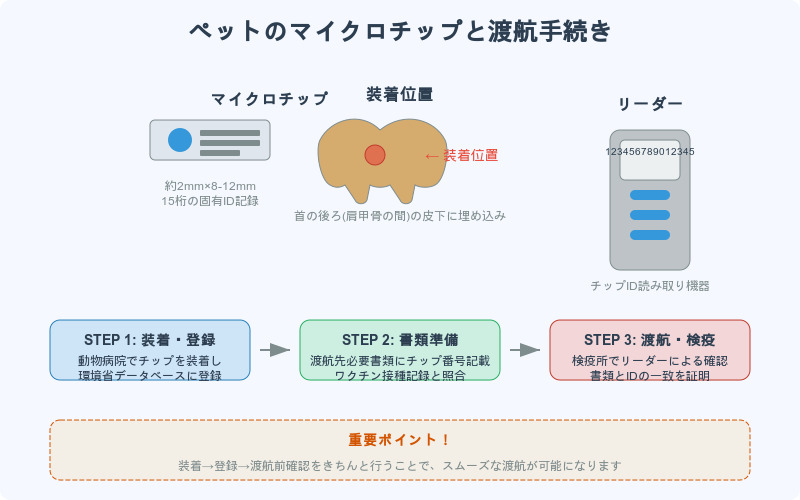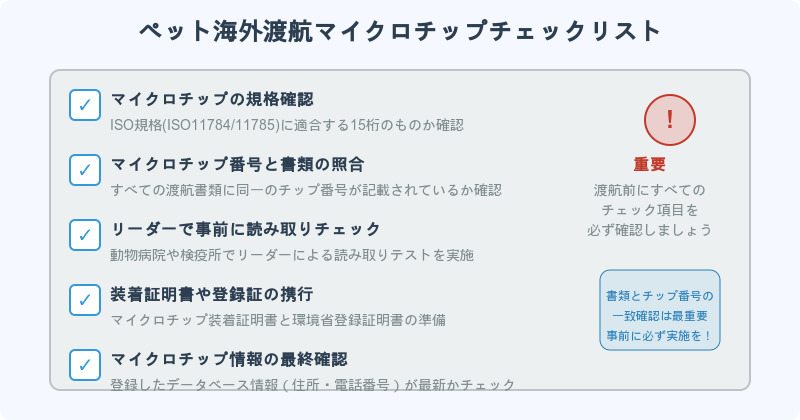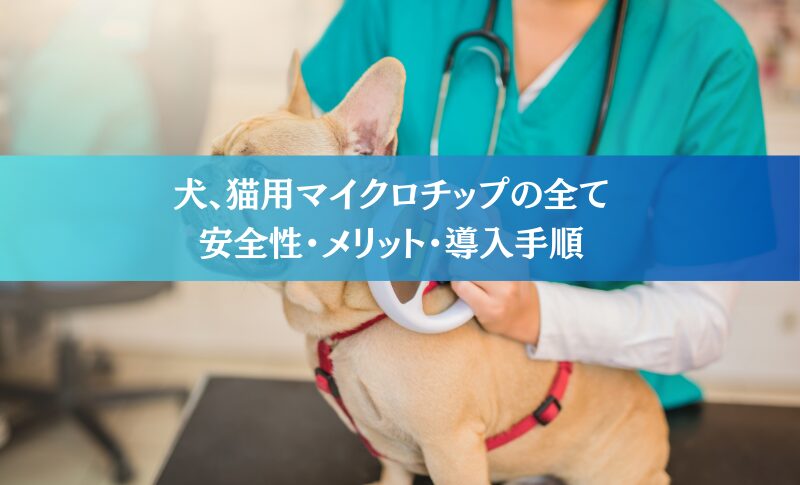When you travel abroad with your pet (dog or cat) for the first time, you may be asking yourself, "Is a microchip really necessary? How should I prepare?" Many people may feel uneasy. In this article,Pets Microchipping Overseas TravelThis section provides easy-to-understand explanations for beginners, from basic knowledge to preparatory procedures regarding the
It covers the necessity of microchipping in Japan and the law, reasons why microchips are required when traveling abroad, how to install them and the cost, checkpoints before traveling, as well as stories from actual owners and FAQs (frequently asked questions). We provide highly professional and reliable content, citing information from official organizations as well.
After reading this article, your questions about "Dogs Cats Microchip Necessity" will be answered and you will be able to proceed with your preparations for traveling abroad with your pet with peace of mind.
What is a microchip? Necessity and Laws in Japan
A microchip is an electronic tag encapsulated in a glass capsule approximately 2 mm in diameter and 8 to 12 mm in length, with the world's only 15-digit identification number recorded inside. By holding the tag over a dedicated reader, the identification number can be read and compared with the pet owner's information registered in a database to confirm the pet's identity.
Unlike collars and lost tags, there is no risk of losing the device because it is implanted in the body. Once attached, the device does not require batteries and functions semi-permanently (approximately 30 years). It is truly an "in-body identification card" for your pet.
In Japan, the importance of microchipping pets has increased due to the endless cases of dogs and cats that are lost or whose owners are unknown at the time of a disaster. Against this backdrop, the revised Animal Protection and Control Law was enacted in 2019, making it mandatory for dogs and cats to be fitted with microchips and have their information registered from June 1, 2022.
Specifically, dogs and cats sold by breeders and pet stores must be fitted with a microchip, and the purchaser (new owner) is required by law to register changes to their information in the Ministry of the Environment's database. In addition, if a microchip is later installed in a pet already owned, the owner's information must be registered in the same way.
It is recommended that dogs and cats kept before the date of enforcement be fitted with the device as much as possible in case they are lost or in case of a disaster, although it is positioned as an "effort obligation" (it is desirable that they be fitted as much as possible).
When a microchip is installed at a veterinary hospital, a "microchip installation certificate" is issued, which is used to register the information by the pet owner (most veterinary hospitals will provide registration information at the same time the chip is installed). After registration, a "Registration Certificate" will be issued, and a tag with an identification number and contact information for registration can be attached to the pet's collar.
Be sure to submit a notification of change of registration when there is a change in registered information (change of address, transfer, etc.) (notification of the change itself is free of charge). Since the enforcement of the law in Japan, microchipping is becoming increasingly popular not only among pet suppliers but also among pet owners in general.
Microchipping is an important precaution for dog and cat owners in case their pets are lost, stolen, or in the event of a disaster. Even if you are not required by law to have your dog or cat microchipped, please do not think that "my child will be fine," but rather consider it as a precautionary measure.
Why do I need a microchip for international travel?

When taking a dog or cat abroad, microchipping should be considered almost a requirement. Many countries strictly enforce individual pet identification from the viewpoint of disease prevention, such as rabies. For this reason, many countries require microchip identification for quarantine and issuance of health certificates at the time of entry into the country.
Although detailed rules differ from country to country, "microchip implantation in accordance with ISO standards" and "submission of vaccination certificate with microchip number" are basic requirements common worldwide. For example, the Japanese Animal Quarantine Service (Ministry of Agriculture, Forestry and Fisheries) requires "identification by microchip," "rabies vaccination history," and "proof of antibody titer test" for pets entering Japan from outside designated areas, and clearly states that all documents submitted must include the microchip number.
In the European Union (EU), the pet passport system requires a 15-digit microchip compliant with ISO 11784/11785 and proof of rabies vaccination. The United States of America also imposes an international microchip requirement for dogs imported from high-risk rabies countries after 2021, and requires that the microchip be "readable by a universal scanner.
Thus, looking at the rules in countries around the world, you should assume that you cannot board a plane or enter a country without a microchip.
In international pet travel, the microchip serves as a de facto passport.

The first step at the airport quarantine station is to read the microchip. If the chip can't be read, you can't proceed to the next step.
A microchip reader confirming individual identification. At airports and quarantine stations, the staff member uses a special handheld scanner to read the chip implanted in the pet's body and confirm the ID number. The microchip number is checked against the vaccination certificate and quarantine documents to prove that the pet is identical to the individual on the documents.
In the worst case scenario, if the chip is not installed or cannot be read, the pet may be denied entry into Japan or quarantined for an extended period of time. In addition, microchips are more widely used as proof of identity for pets overseas than in Japan.

When I once took my dog to Europe, I temporarily panicked at the airport because I could not read the chip. In the end, I was able to confirm the chip with another reader, but I realized the importance of prior testing.
In the unlikely event that a pet is lost and found in a destination country, a microchip increases the likelihood that a local animal shelter or veterinarian will be able to scan it and contact the owner. In fact, it has been reported that lost pets with microchips are much more likely to be returned to their owners. In this sense, a microchip is a great reassurance to protect your beloved pet in a foreign country.
Microchip installation method and cost
When you hear the words "microchip" you may be worried that it will be painful or that you will feel sorry for your pet. However, the actual procedure is almost as simple as a vaccination injection. A veterinarian at a veterinary hospital uses a special injector to implant the chip under the skin at the back of the dog or cat's neck (between the shoulder blades).
The needle is slightly thicker than a normal injection needle, but the procedure usually requires no anesthesia or sedation and is completed in an instant, so the burden on the pet is negligible. In fact, according to the Japan Veterinary Medical Association, there have been no reports of serious side effects or shock symptoms caused by microchipping, and the safety level is even higher than that of vaccinations.
The pain of needle insertion is comparable to that of a vaccine injection, and once implanted, the pet does not feel any pain.

My boy hardly reacted at all when he was microchipped. The vet said that many children do not suffer more pain than a vaccine shot. I was worried about it, but to my surprise, it was over very easily!
A dog is being microchipped at a veterinary clinic. The veterinarian injects the microchip under the skin of the dog's neck using a special injection device. The procedure takes only a few seconds and can usually be performed without anesthesia.
After placement, the reader reads the chip number to confirm that it is correctly implanted. The pain is instantaneous and the burden on the pet is minimal. The cost of the implantation varies slightly depending on the hospital and the size of the animal, but is generally around several thousand yen (around 5,000 yen).
In some cases, the cost is less than 5,000 yen for small dogs and cats and close to 10,000 yen for large dogs, but it is not an extremely expensive burden compared to vaccinations. Some local governments subsidize part of the cost of microchip installation, so it is a good idea to check the system in your area.
Also, as mentioned above, there is a separate fee for information registration, but it is a small fee of 400 yen for an online application. As for the timing of installation, we recommend that it be done as early as possible. By law, dogs can be fitted at 2 weeks of age and cats at 4 weeks of age.
Puppies and kittens are small and may be anxious during this period, but it is better to have the surgery done when they are young rather than when they are grown up, so that there is less burden on them and they can have peace of mind in case of an emergency. There is also a method in which the pet is placed under general anesthesia while being spayed or neutered, and if done at the same time, the pet will not feel pain while under anesthesia.
You can consult with a veterinary clinic for a flexible solution. After the microchip is installed, do not forget to register it with the Ministry of the Environment database mentioned above. A microchip that is not registered is useless. Even if you have gone to the trouble of implanting a microchip, if the owner's information is not linked to the database, you will not be able to be contacted even if your pet is lost and taken into custody.
Once implanted, a microchip is valid for life. However, database registration is required by law and is meaningless if unregistered. Be sure to update your registration information when you change your address, etc.
Please complete the registration procedure as soon as you receive the installation certificate from the veterinary clinic and keep the registration certificate in a safe place. Once the registration is completed, you may wish to attach a charm such as "I have a microchip" to the collar in place of a dog tag tag.
Points to check before traveling (checklist)

Once your pet has been microchipped, it is time to check the following points in advance for international travel.
Check microchip standards
Make sure that the chip you have implanted is ISO standard (ISO11784/11785) compliant with 15 digits. Most commercial chips are ISO compliant, but older chips or those installed overseas may rarely be non-compliant.
If the chip conforms to international standards, it can be read by the quarantine authorities in each country without problems, but if it is out of standard, it is safer to prepare your own reader or consider re-installation. Especially in the EU, if the chip is not ISO compliant, the owner is required to bring the reader with them when entering the country. If you are concerned, please consult your veterinarian to be sure.
Verification of microchip number and documents
In preparation for travel, you will need to prepare various documents such as vaccination certificates and export quarantine certificates, but be sure to check that the pet's microchip number is correctly listed on all documents. If the number on the document is different from the actual number on the pet, the number will be invalidated.
The main rule is that the rabies vaccination must be given after the microchip is installed (vaccines before the chip is installed are not officially allowed). Please note that if a rabies shot is given before the chip is installed, it will be necessary to re-administer the vaccination and antibody test after the chip is installed.
Pre-reading check with reader
Before traveling to Japan, have the chip read tested once at a veterinary clinic or quarantine station. It may be difficult to read the chip depending on where it is mounted, so it is a good idea to check in advance. Especially if the chip has been in place for a long period of time, it may be moved in rare cases, but it usually stays around the neck.
If the reading is normal, it is OK, but in the unlikely event that it is not, consult your veterinarian immediately (it may be necessary to reattach the device or take other action).
Carrying a certificate of fitting or registration
A microchip certificate (issued by a veterinarian) and a registration certificate from the Ministry of the Environment are good documents to have with you when traveling, just in case. Although the quarantine office will basically ask for a health certificate with the chip number, a certificate of microchipping may make it easier to explain the situation to local officials.
You may also be asked to present a certificate of chip installation at the animal quarantine procedure when leaving Japan, if the chip has been installed in Japan. Keep this information in a file.
Final confirmation of microchip information
Confirm that the registered database information (address, phone number, etc.) is up-to-date. If there are any changes in contact information due to relocation overseas, update the Japanese database as well before leaving Japan.
In addition, if your destination country has a separate registration system (e.g., obtaining a pet passport in the EU), do not forget to register your pet locally. The Japanese Ministry of the Environment database is for domestic use, but the microchip number itself functions as a universal ID.
When a pet is protected locally, the number may be used to contact the owner through Japanese databases or international registration sites (e.g., Global Database for Pet Microchip Registration). It is important to have a contact number tied to the pet that can be reached no matter where you are.
If you keep the above points in mind beforehand, you will be able to avoid most of the problems related to microchips. In particular, we recommend that you make sure to carry out the following three points: "confirmation of the standard," "checking against documents," and "reading test.
In preparing for your trip, check the above checklist one by one and make sure that all items have been checked before you leave. In particular, checking the documents against the microchip number is of utmost importance.
If you are well-prepared, you will be able to avoid the "I can't read my chip! You should be able to pass through quarantine smoothly.
Owner's story: Microchip gives peace of mind to go abroad
Even if you know that your pet needs a microchip for overseas travel, you may still be concerned about whether or not you will be able to complete the procedure properly and whether or not it will be safe for your pet. Here we introduce some episodes from pet owners who have actually traveled abroad with their pets.
The voices of seniors who have overcome the same problems will surely provide reassuring hints.
Owner A (traveling to the U.S. with his dog)

The thing that worried me the most in preparation for my trip to Japan was the microchip. I was afraid that it would hurt, but the installation went quickly and I was relieved. My poodle (toy poodle) was fine and didn't seem to be bothered by it afterwards.
On the day of my flight, when the airport quarantine officer read my chip with the reader and said, "Yes, it's OK," I was really glad that I had installed the chip! I was so glad that I had worn the chip! Thanks to this, immigration procedures went smoothly and we were able to start our life in the U.S. together without incident.
Owner B (to Europe with his cat)

I was told that Europe absolutely requires a microchip and proof of rabies vaccination, so I prepared early. It was a long process, with a rabies vaccine immediately after the chip was inserted, followed by a 180-day waiting period, but thanks to the chip, all the documents were linked properly, giving us peace of mind.
Before leaving the country, I asked the hospital to check the chip reading just to be sure, and the numbers matched. I was able to enter Europe without any problems. I also got a pet passport there, and the vet said "Good! It was a lot of work, but if you plan ahead, you will be fine!
Owner C (reentering Japan with his dog after being posted overseas)

I left Japan once for an overseas assignment and returned to Japan two years later. The microchip was a big help both when I left and returned to Japan. In particular, when I returned to Japan, I contacted the Japanese quarantine office in advance to prepare the necessary documents, and they immediately recognized me as the dog with the microchip number XX.
I realized that a microchip is a substitute for a pet's passport after all. If I had not had the chip, it would have been more complicated, and more importantly, it gave me peace of mind as a measure against strays while living overseas. In fact, once I lost my dog while out walking and had to be protected, but thanks to having the chip read, I was able to get a call and pick him up right away.... Once again, I am glad I had the chip installed.
What do you think? Although some senior pet owners had some initial misgivings, they were able to realize smooth and secure pet travel by utilizing the microchip.
Microchipping is not a painful process for pets, but rather a reassuring talisman that protects both pet owners and their pets. Please do not be dismissive of microchipping, saying, "My child is the only one who never gets lost," or "The procedure seems like a hassle.
Frequently Asked Questions (FAQ)
Finally, here are the most frequently asked questions and answers about microchipping pets and international travel. If you have any remaining concerns or questions, please check them out.
Q: Is it still necessary to have a microchip installed when traveling abroad?
A: It is almost always required. In most cases, it is also legally required as a condition of entry into each country. For example, all major countries such as the EU, Japan, and the U.S. require identification by microchip.
If you do not have a chip, there is a high risk that you may not be allowed to enter the country or you may be subject to long-term quarantine.
Q: Does it hurt to wear it? Will it have any negative effects on my body?
A: The pain is about the same as a vaccine injection and is usually so slight that no anesthesia is needed. The procedure itself takes only a moment to complete as the needle is inserted.
The risk of side effects is extremely low, and safety is well established. In Japan, there have been no reports of health problems caused by microchips, and since they are covered with biocompatible glass, allergic reactions are unlikely to occur.
The area where it is attached may swell temporarily on rare occasions, but this will subside spontaneously. If you are unsure, consult your veterinarian before proceeding.
Q: How much does it cost to microchip and register my dog?
A: The cost for the microchip and installation is approximately 5,000 to 10,000 yen (depending on the veterinary hospital and the size of the pet). The cost is usually around 5,000 yen for a small dog and 10,000 yen for a large dog.
In addition, there is a registration fee of 400 yen for online application to the Ministry of the Environment database. It is not cheap, but it is a reasonable investment considering that once installed, it will last a lifetime. There are cases where local government subsidies are available, so please check with your local government.
This will make you feel more secure. However, please understand that the microchip itself has no tracking function.
Official Line Registration and Free Online Interviews
Preparing for overseas travel with pets involves a lot of work and anxiety. To support such pet owners, we provide information via our official LINE and offer a free online interview service.
If you read the article and feel "I would like to discuss this in more detail," or "How should I prepare for my pet?" Please feel free to contact us if you feel "I want to discuss this in more detail.
Official LINE Registration
The latest travel information, checklists, and updates on quarantine rules in each country are distributed on LINE. If you add us as a friend, we will answer your individual questions via chat.
Our professional travel preparation staff will back you up so that you can proceed with your preparations without being isolated.
\ First of all, free consultation on line! / /

Consultation is completely free of charge.
Free online consultation is also available.
Weekends and holidays are also available.
Free online interview (appointment required)
We offer a free 30-minute online interview with a professional pet travel consultant who can provide one-on-one support. We can provide advice tailored to your individual circumstances, confirm the flow of procedures, check required documents, and any other details.
You can participate from the comfort of your own home and ask even the smallest questions such as "Is it OK to ask this? You can also directly ask questions such as "Is it OK to ask this?
▶︎ How to use
First, please register on our official LINE and make an appointment for an online interview from the rich menu. A representative will contact you to arrange a date. Of course, you are welcome to ask simple questions on the line.
Preparation is the key to traveling with pets, but you don't have to worry about it alone. By consulting with a specialist as you proceed, your anxiety will be replaced by confidence and the procedures will go much more smoothly. Please take advantage of our official LINE and free consultation service to realize an enjoyable overseas life with your precious family member (pet)!
summary
We have explained everything from basic knowledge about microchipping pets to preparing for overseas travel. Microchipping is not only a legal obligation, but also a powerful tool to protect the safety of your pet. Although there may be a lot of anxiety when traveling abroad for the first time, if you are well prepared, you will be fine.
Useful for identification in case of lost children or disasters
Proof of identity required for overseas travel
Lifetime validity after a single installation
Ensures peace of mind for pets and owners
References
Official information on microchipping and information registration by the Ministry of the Environment
Gunma Prefecture Information on the promotion of microchipping for dogs and cats
Niigata Prefecture Animal Protection and Management Information
Animal Quarantine Service, Ministry of Agriculture, Forestry and Fisheries Information on import and export of pets
Veterinary Information Site

Explanation of all procedures required to bring pets from Japan to overseas. From microchipping to vaccinations and quarantine, this is a complete guide in chronological order, covering preparations that should be started 6 months in advance. It also covers the latest regulations and introduces detailed country-specific requirements. Supports safe overseas travel.
Please share your experiences and opinions!

Do you have any experiences or questions about traveling abroad with your pet?
If you have actually experienced this, please share with us the points you took care of in your preparation and any problems you had while traveling. We also welcome questions from those who are thinking of traveling to Japan in the future.
Please feel free to comment on any concerns you may have, such as
Your comments will be of great help to others who are struggling with the same issues. Please share your thoughts and questions in the comments section below!
![Support for pets traveling and moving overseas|PetAir JPN [Official] for international transportation and quarantine procedures for dogs and cats Support for pets traveling and moving overseas|PetAir JPN [Official] for international transportation and quarantine procedures for dogs and cats](https://petair.jp/wp-content/uploads/2024/08/main_logo.png?1765119686)



Comment